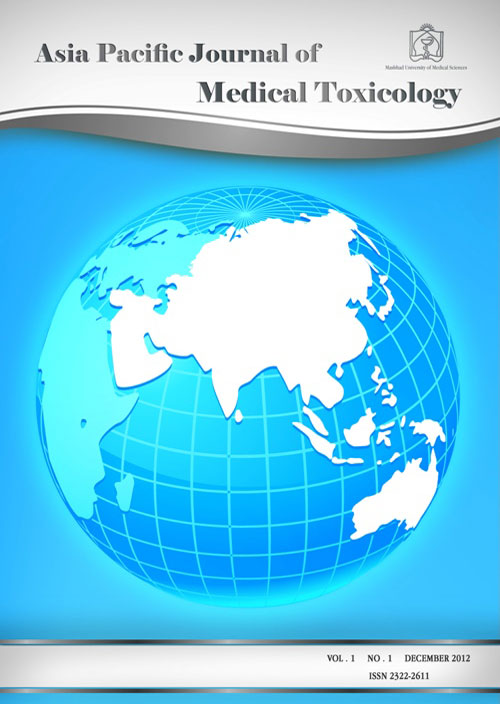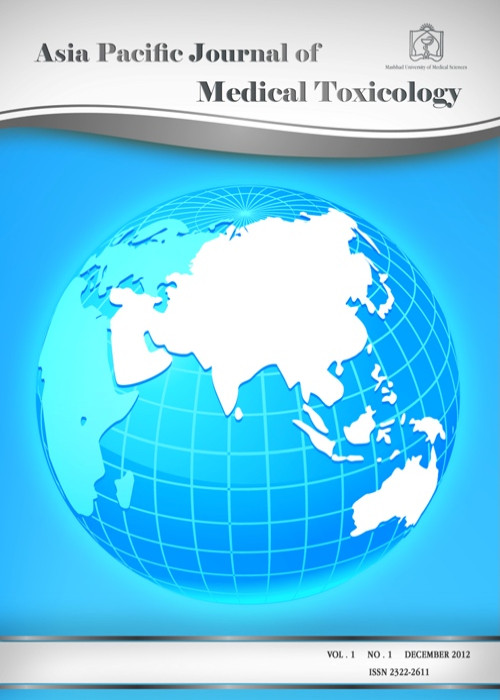فهرست مطالب

Asia Pacific Journal of Medical Toxicology
Volume:11 Issue: 2, Spring 2022
- تاریخ انتشار: 1401/04/13
- تعداد عناوین: 8
-
-
Pages 40-45BackgroundExposure to poisoning can be accidental, suicidal, or homicidal. There is a progressive increase in the misuse of natural and unnatural toxins with increased morbidity and mortality rates. With insufficient databases about the pattern and the outcome of poisoning, no plans can be achieved for prevention and management. So, the aim of the present study was to outline the pattern and outcome of acute poisoning in Alexandria Poison Center (APC), Egypt. Subjects andMethodsA retrospective cross-sectional study was carried out and included all patients admitted to APC from the 1st of June to the 31st of December in the year 2019.ResultsThe total number of admitted poisoned patients in APC was 3881 in 6 months period. The highest incidence of poisoning occurred under the age of 10 years (32.9%) and females outnumbered males. It was noticed that there is significant difference regarding suicidal tendencies where it was higher in females (44.6%) than in males (21.2 %). The most common intoxications were by corrosives (34.9%) followed by pesticides (33. 7%), food poisoning (23.3%) and CNS drugs (23.1%). Most of the poisoned cases (99%) stayed for approximately 1.5 days. Full recovery was the outcome in 99.6% of cases, whereas 0.3% of males and 0.1% of females left without discharge and 0.1% of each gender suffered complications.ConclusionThe highest percentage of poisoning occurred below the age of 10, with female predominance in poisoning and suicidal tendency. The most common agents involved were corrosives, pesticides, followed by medication overdose and food poisoning. The good outcome of cases was due to the availability of antidotes and trained personnel.Keywords: Alexandria, poison centers, Acute poisoning, toxicology, Egypt
-
Pages 46-50BackgroundOne of the major risk factors in cardiovascular diseases is Opiate abuse. Accordingly, the present study aims to investigate the complications and consequences of myocardial infarction between Abusers and Non-abusers of Opiate in the south of IranMethodsThe present study is a cross-sectional work of research. 1800 myocardial infarction (MI) patients at Fasa Registry on Acute Myocardial Infarction (FaRMI) were selected for study. Data were collected from 2015 to 2020. The collected data were analyzed in SPSS v. 22 using the statistical tests of independent t-test and chi-square. Significance level was set at p<0.05.ResultsOut of the 1800 patients, 593 (32.9%) were female and 1207 (67.1%) were male. The rate of Opiate abuse in the study population was found to be 25.6. The results showed a significant relationship between the Opiate patients’ average age and gender on the one hand and Opiate abuse on the other (p<0.001). Also, Opiate abuse was found to significantly correlate with hypertension, diabetes, and hyperlipidemia as risk factors in AMI (p<0.001).ConclusionGiven the prevalence of Opiate abuse and its role in cardiovascular diseases, especially AMI , in the present study, it is recommended that the senior administrators in the healthcare system take effective measures to raise public awareness about the potential harms of Opiate abuse.Keywords: Opiate abuse, Myocardial infarction, Cardiovascular diseases, Iran
-
Pages 51-57Background‘Prinso’ is a fabric stain remover, which is consisted of two sachets, one containing brown crystals (potassium permanganate) and the other white granules (calcium oxalate). The product is made by small scale manufacturers of Sri Lanka and has become popular as a remover of stains. Recently, deliberate self-poisoning with ‘Prinso’ has become common in both rural and urban areas of Southern Province of Sri Lanka.MethodsA prospective clinical study was conducted in Teaching Hospital Ratnapura, Sri Lanka over 3 years commencing from July 2017. Epidemiological data, clinical features, treatments, and outcomes were collected. The data were analyzed through SPSS software version 21, using descriptive statistics.ResultsThere were 274 (9.5%) patients with ‘Prinso’ poisoning out of which 140 (51%) were males and 134 (49%) were females. All were deliberate self-poisonings and 117 (43%) ingested oxalate alone; 31 (11%) ingested only permanganate, and 126 (46%) ingested both chemicals. The age ranged from 13-80 years (mean 31.6 ± 14 years) and the most commonly affected age group was 12-31 years (165;60%). The majority of patients were unemployed (108;39%) and 22 (8%) schooling children. Most patients (n=145;53%) were admitted to hospital within 1-4 hour of the ingestion (median 2 hrs and IQR 2-4 hrs) from Ratnapura (n=74;27%). Most of them (n=78;28.5%) were treated at hospital for 3 days (mean 4.8 days, IQR 2-6 days). Decontamination was done for 88% (n=239). Gastrointestinal symptoms including nausea (n=90;33%), vomiting (n=193;70%) and epigastric pain (n=141;52%) occurred frequently. The main complications among the patients were acute kidney injury [AKI] (110;40%), hypocalcemia (38;14%), hypotension (29;11%), ECG changes (27;10%), and methemoglobinemia (26;9.5%). Hemodialysis was done for 39 (14%) and 20 (7%) were treated at intensive care unit from which 13 (5%) were intubated. Methylene blue (antidote) was given to 25 (9%). Leukocytosis was observed in 118 (43%) patients and 236 (86%) were recovered. Despite medical attempts, 22 (8%) died. Case fatality rate for ‘Prinso’ poisoning was found to be 6.6% (90% CI 2.3-13.4;P < 0.05).Conclusions‘Prinso’ is a deadly poisoning household agent and AKI is the most common clinical manifestation.Keywords: Oxalate, Acute kidney injury, Methemoglobinemia, Methylene blue, Washing Powder
-
Pages 58-61ObjectiveThe insertion of central venous catheters in patients with chronic renal failure and poisoning is a vital step for these patients. Therefore, it is necessary to know the complications and clinical applications of these catheters. The aim of this study was to identify catheter complications in patients with Shaldone dialysis catheter and the choice of the best method for preventing the occurrence of these complications in patients.MethodsThe study population consisted of all patients, who were admitted in the ICU poisoning for dialysis and used Shaldon's catheter. Information including age, sex, cause of admission, duration of admission, duration of catheterization, the type of complication, and the use of Shaldon's catheter were extracted from patients' files and special forms.ResultsAmong the 80 patients, who had Shaldone's catheter, 59 were uncomplicated and 21 were complicated. The most common complication was catheter site infection (8.8%). There were 5% of patients with pneumothorax, 5% with bleeding, 2.5% with thrombosis, 1.3% hemothorax, 1.3% hematoma, 1.3 % pneumothorax plus hemothorax, and 1.3% catheter site infection along with thrombosis.ConclusionsAccording to the pertinent literature, if the experienced patients practice catheterization, the internal jugular catheter is a more appropriate and feasible approach than femoral. It is recommended to conduct catheterization by experienced individuals with the introduction of a catheter and under the guise of ultrasound to minimize the occurrence of some complicationsKeywords: Catheter, Complications, hemodialysis, Poisoning
-
Pages 62-71Background
For nearly a century, aluminum hydroxide (alum) has continued to be employed as an adjuvant in vaccinations. It was first applied by immunologist Alexander T. Glenny in 1926 to boost the immune response. Its great efficiency has allowed aluminum to continue to be used to date.
MethodsRecognized scientific databases such as Google Scholar, Web of Science, and PubMed were utilized to search for the keywords. The selected works were reviewed and analyzed according to their relevance. Only peer-reviewed articles were included in the analysis.
ResultsContemporary research carried out on animals has shown that it has a neurotoxic effect. Furthermore, increased aluminum concentrations in the nervous system tissues of people, who died from an autism condition have been discovered by using advanced imaging techniques. The paradigm shift proposes a reconsideration of the use of the alum-based adjuvants and calls for a careful dissection to avoid incorrect interpretations. This proposal does not constitute an attack on vaccination, as nobody refutes the fact that it has been systematically proven to be effective in saving millions of lives. Unfortunately, scientists, who have investigated the toxicity of aluminum-based adjuvants have been unfairly labeled as “anti-vaxxers”. Rather, what they have been questioning is the safety of aluminum as an adjuvant.
ConclusionsThe present work encourages researchers, health regulatory agencies, and even pharmaceutical companies to allow themselves to think about the possibility that aluminum-based adjuvants could be toxic for susceptible children.
Keywords: Autism, Neurotoxicity, Vaccination, Paradigm shift -
Pages 72-76Background
Testing of substances such as drugs, food, cosmetics, and chemicals meant for human utilization requires necessary guidelines to be followed. It was recently observed that the proposed duration protocols for subacute, subchronic, and chronic toxicity tests are miscomprehended and misapplied by some researchers.
MethodsThis short evaluation, revealed areas where terminologies related to systemic toxicity test durations were misapplied and also properly applied. Data from recently published articles from peer reviewed journals were explored via Pubmed, Google Scholars, and Web of Science database using specific keywords such as “guideline on subacute, subchronic, chronic toxicity testing”, “subacute toxicity study”, “subchronic toxicity studies”, and “repeated toxicity studies on plant extracts”, and “6 months chronic toxicity test”. The articles that deviated form or complied with the standard test duration protocol were selected for scrutiny in the present study. The need for proper adoption of appropriate terms when developing topics for repeated toxicity test results was also discussed in this study.
ResultsThis study indicated that although some scholars conducted repeated dosing for 14 or 28 days, they incorrectly used the term “subchronic” instead of “subacute” in the titles of their studies. Also, the term “chronic” was used instead of “subchronic” in the titles of some studies conducted for 90 days.
ConclusionThis study would enable researchers and reviewers of manuscripts in peer review toxicology journals to be acquainted with the laid down test duration protocols for subacute, subchronic, and chronic toxicity tests to ensure that previous errors are not repeated.
Keywords: Toxicity tests, Subacute, Subchronic, Chronic, Nomenclature -
Pages 78-79Objective
To report a case of Ciprofloxacin induced Ocular Toxicity.
Case SummaryA 75-year-old male patient was admitted to the Department of Ophthalmology for Cataract Surgery of his left eye. He was prescribed topical Ciprofloxacin 0.3% preoperatively four times daily for 5 consecutive days. After 4 days he had complaints of itching, redness and swelling in the periorbital area of the left eye. He visited the outpatient clinic and was admitted. Therapy was discontinued, and the physician prescribed medications to address symptoms. He recovered within one month.
DISCUSSIONFluoroquinolones can elicit a delayed type of hypersensitivity reaction which is mainly T cell-mediated. Ocular toxicity commonly arises due to ciprofloxacin administration but is seldom reported. Swelling, redness and itching of the eye have been rarely reported. The exact mechanism behind such an adverse drug reaction is unknown and might be due to patient hypersensitivity to the fluroquinolone group of antibiotics.
CONCLUSIONTopical ciprofloxacin medications may lead to ocular toxicity and caution is needed while using these eye drops in patients. Also, these kinds of adverse reactions must be carefully reported.
Keywords: Ciprofloxacin, ocular toxicity, adverse drug reaction


